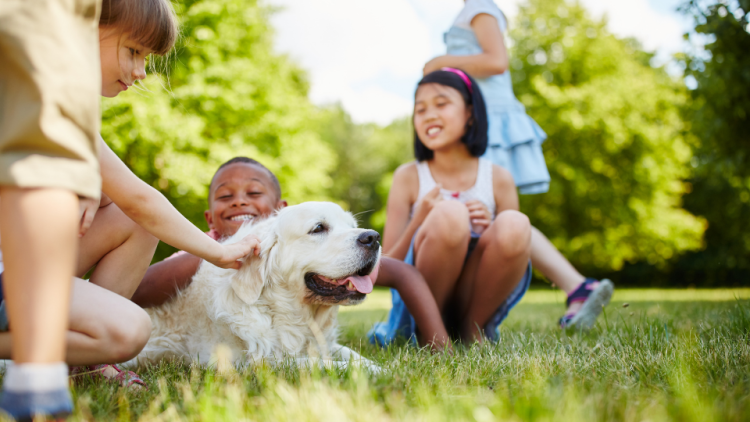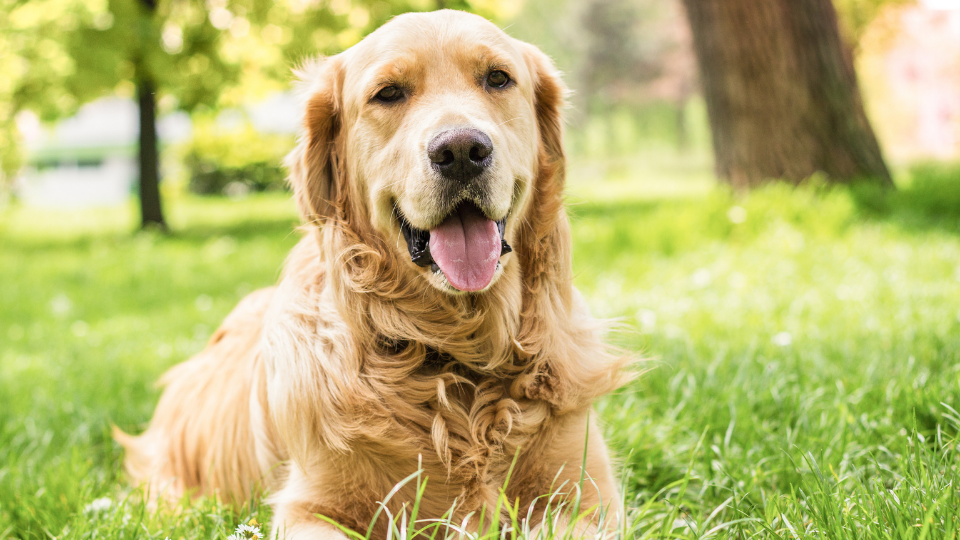With its gentle nature, smiling face, floppy ears, and beautiful coat, the Golden Retriever is one of the most popular dog breeds in the United States, ranking fourth on AKC’s list of most popular breeds. These smart, friendly, and loyal dogs make perfect family pets and their intelligence makes them highly capable working dogs. Could this be the right choice for you and your family?
Read on to find out more in our complete pet guide on Golden Retriever .
Table of Contents
- Golden Retriever breed history
- Golden Retriever characteristics
- Golden Retriever care tips
- Common Golden Retriever health problems
- Adopting or buying a Golden Retriever dog
- Key Takeaways
Pro Tip: Although your Golden Retriever will most likely have a long and happy life, it is good to be aware of the health risks and take steps to protect them as best you can. Purchasing the right pet insurance can help put your mind at ease should your pet friend suffer an injury or illness throughout their lifetime.
Golden Retriever breed history
Golden Retrievers were developed in Scotland, where they were originally used as hunting dogs, retrieving birds in the water and on land.
The breed gained popularity in England and was recognized by The Kennel Club of England in 1911 as "Retriever — Yellow or Golden." In 1920, the breed name was changed to Golden Retriever. A few years later, Goldens were introduced to the US as both companions and hunting dogs. The breed was officially recognized by the AKC in 1925.
Golden Retriever characteristics
Physical appearance
The average weight of a Golden Retriever is between 65 and 75 pounds for males and from 55 to 65 pounds for females. Golden Retriever males reach between 23 and 24 inches in height whereas females range from 21 to 22 inches.
The Golden Retriever has a well-balanced body with a deep chest and a strong and broad head. The ears sit high on top, hanging just below the jawline.
The members of this breed have a water-repellent coat that is flat or wavy, feathering on the thighs, legs, neck, tail, and underside. The coat comes in three different colors:
- Golden
- Light Golden
- Dark Golden
Temperament and personality
The Golden Retriever temperament is cheerful, gentle, and trustworthy. According to the American Temperament Test Society (ATTS), 85.60% of the Golden Retrievers that were tested passed the Temperament Test.
These playful pups tend to get along well with children, other pets, and strangers. They like to work and are eager to please, which is why they are so popular as service dogs.
Golden Retrievers are not known to be barkers and they tend to lack strong guard instincts, so they don’t make good watchdogs.
Average lifespan
The average lifespan of Golden Retrievers is between 10 and 12 years, which is about the same as other dog breeds of their size.
The oldest Golden Retriever on record was Augie from Tennessee, who reached the age of 20 years and 11 months before passing away in 2021.
Cancer is one of the main causes of death for this breed. According to a study by Morris Animal Foundation, 60% of Goldens are impacted by cancer, which is about double the rate of any other dog breed.
The best way to increase the longevity of your Golden Retriever is with proper care, regular veterinary visits, exercise, and diet.

Golden Retriever care tips
Training and exercise
As with all dog breeds, puppy training classes and early socialization are recommended in order to help your Golden Retriever grow into a well-adjusted and well-mannered adult dog. Goldens are eager to please their owners, which makes them very easy to train.
These energetic dogs require plenty of exercise. If they don’t get enough activity, Golden Retrievers are likely to develop undesirable behaviors. They make great companions on bike rides and long runs, but also enjoy field trials, hunting trips, as well as canine sports such as obedience, tracking, and agility. Sports are a great way to get your Golden the mental and physical exercise they need.
Diet and nutrition
Golden Retriever puppies grow rapidly between the age of four and seven months, which makes them susceptible to bone disorders. For this reason, they should be on a low-calorie diet that prevents them from growing too fast such as a large breed puppy diet. Your veterinarian is the best resource for additional guidance on what food is best for your Golden Retriever puppy.
Adult Goldens are typically fed around 1.5 cups of dry dog food per meal, twice a day. Being food-lovers, these big pups are prone to getting overweight. You should avoid free feeding and giving too many treats.
Keep an eye on your dog’s calorie intake and be sure to contact your vet if you notice weight gain. Your vet will provide recommendations regarding the amount and type of food, exercise, and feeding schedules.
Your Golden Retriever's exact nutritional requirements may vary based on their size, age, activity level, and food brand. You should always consult your veterinarian if you are unsure about the best food type or volume for your dog.
Grooming requirements
In general, Golden Retrievers shed their thick double coat moderately and should be brushed once or twice a week to remove the loose hair. During times of more profuse shedding shed (during fall and spring or year-round in temperate climates), brushing should take place on a daily basis.
Goldens only need occasional baths to keep them clean, as well as regular nail trimming and teeth cleaning.
Living with a Golden Retriever
Goldens are very active dogs. If regular exercise is provided they can easily adapt to any type of home, even an apartment. Being bird dogs at heart, Goldens love swimming and playing a game of fetch.

Common Golden Retriever health problems
Golden Retrievers are a generally healthy breed but, as mentioned before, they are at a slightly increased risk of cancer compared to other dogs. The most common cancers in Golden Retrievers include hemangiosarcoma and lymphoma.
Other health conditions that affect this breed include:
- Hip dysplasia, a joint condition that results in instability or a loose fit of the hip bones.
- Elbow dysplasia occurs when the bones that make up the elbow joint don't come together right, resulting in painful movement in the forelimb.
- Gastric dilatation-volvulus, also known as bloat, is a life-threatening disorder characterized by abnormal twisting of the stomach.
- Osteochondrosis, an inflammatory condition in which diseased cartilage separates from the adjoining bone.
- Hypothyroidism, a common endocrine disease of dogs that occurs when the thyroid glands fail to produce adequate amounts of hormones.
- Eye issues, such as progressive retinal atrophy and cataracts.
Pro Tip: You want to ensure that your four-legged friend has the best care possible, so getting Golden Retriever pet insurance may be worth it, given that this breed’s common health issues can be quite costly.
Adopting or buying a Golden Retriever dog
If you’re thinking about adopting a Golden Retriever, check your local rescue groups and animal shelter, as well as the following nationwide rescue groups like Golden Retriever Club of America and Golden Retriever Rescue Resource for online resources to help you find one.
If you are interested in similar breeds, take a look at Labrador Retrievers, Saint Bernards, and Newfoundlands.
Key Takeaways
- Well-loved for their sunny disposition and gorgeous coat, Golden Retrievers are active and playful dogs eager to please their owners. Originally bred to retrieve fowl for hunters, these days Goldens are beloved companions and distinguished service dogs.
- These playful dogs need plenty of exercise and prefer open spaces, but can easily adapt to any type of home. If you have small kids, a Golden Retriever is a great choice for a family pet.
- Goldens have a dense, water-repellent double coat, and shed their undercoat twice a year, during which they might require daily brushing. The rest of the year, brushing once a week should be enough.
- The most common health issues affecting the breed include cancer, hip dysplasia, elbow dysplasia, etc.
